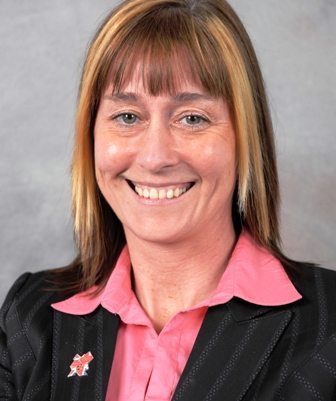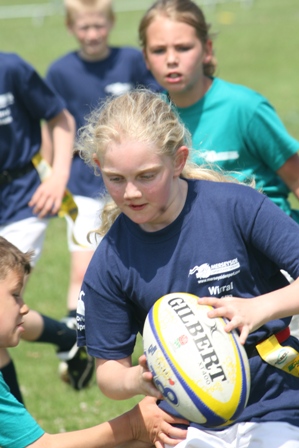
Jean Stephens
Games without frontiers
Youth Games have been delivered in various parts of England for two decades and led the development of county sports partnerships. With the sun cracking the flags, The Leisure Review visited Merseyside’s latest incarnation and spoke to Jean Stephens, one of the leading lights in the CSP movement.

Jean Stephens
Ten years ago, with the millennium imminent, the world of sports development was being riven by Sport England’s bright idea to celebrate the transition to the 21st century. A number of counties had been persuaded to pilot the Millennium Youth Games concept and a lecture theatre in Southampton hosted some non-parliamentary debrief debates around funding, logistics and the serene stupidity of making teenagers compete at sports hall athletics in the great outdoors. Which was a shame really as the people who already had a decade of experience of the format knew what the sensible counties came to realise, which was that Youth Games, if designed to meet local needs and delivered against developmental objectives, are a useful and enjoyable sports development tool that has the added benefit of being beloved of politicians.
There is no doubt that Lord Coe’s attendance at the Merseyside Primary Games, which coincided with The Leisure Review’s own visit, was motivated by political rather than sporting ends. The North West Development Agency were behind his royal visit and, for all that he was great value and clearly added to most people’s experience, there is a hollow ring to the press release claim that Seb was there “to see how London 2012 is inspiring a generation of young people to take part in sport”. The event was delivering legacy when the good baron was still a backbench MP and the young people of Merseyside will have seen no benefit from LOCOG’s work up till now as the London Olympics organisers’ commitment to keeping their Singapore promises has been restricted to the design and build of sustainable facilities.
But it is hard to be cynical when surrounded by 12,000 young people playing ten different sports in the sunshine and, when dealing with Jean Stephens, the director of Merseyside Sport, just a little dangerous. Like many a leader at the ‘sub-regional’ layer of the sports system, she has antennae attuned to criticism. Indeed our gentle opener – “You head up one of the oldest county sports partnerships…” – was dispatched to the long grass with the correction “one of the more mature” and the tone was set. The truth is that Merseyside Sports, where Stephens has worked for at least a decade, were here before the world had ever heard of county sports partnerships (CSP). Stephens gave the details: “Merseyside Sports Partnerships came together back in the early nineties and funnily enough it was to stage the Youth Games. Back then it was staging the Games that brought the five local authorities sports development teams together to work in collaboration – since then Halton have made it six – and then we started doing pan-Merseyside development. While we weren’t called a county sports partnership, what we were doing and what we were about, our principles if you like, were very much as they are today.”
So in one shape or form the Merseyside partnership has been around for eighteen years and some would say that established partnerships like Stephens’ will be here when the CSP idea has run its course. For those people who are not part of the county sports partnerships layer in the sports system, what exactly is that course? It was only last year that a frustrated Bruce Kelsey of South Yorkshire Sport was complaining that while Sport England’s latest statement “assures us that CSPs ‘will have a role in delivering specific outcomes’, we are no nearer understanding exactly what those outcomes are.” Are things any clearer these days?
“County sport partnerships are very much more strategic,” Stephens said. “Back then [18 years ago] Merseyside Sport would be doing a lot of delivery. But if you have a large partnership, like Merseyside has now, with six fit, strong sports development units doing delivery we don’t need to. We need to add value through strategic co-ordination, generating resources that can be deployed into the partnership. Over this last decade a wealth of partners have joined the local authorities round the table because they have a common thread – sport and physical activity, not just for young people for all people – and we need to glue it all together.”
The phrase ‘added value’ can seem glib and one wonders whether all CSPs add value. Stephens is not convinced: “That is a difficult one.” She pauses, then: “Yes they do. How they demonstrate that is difficult to see sometimes as they are strategic organisations. People see added value as physical cash or more young people being involved and a CSP is only a cog, a part of a longer chain. The bit you add value to – the brokering, the knocking heads together, getting people to pool their resources – may not be seen. They may have been criticised in the past for being inconsistent in their approaches and, although we’ve addressed that now, it was no fault of theirs that they were inconsistent. With the limited resources that we get as a core contract you’re going to look for survival. And different people go to different places.”
Many grassroots sports people struggle to understand the concept of the CSP. To get to grips with it you do need to understand how they are currently funded and Stephens is happy to spend time explaining: “What we’re about as a strategic organisation is the same but how we’re funded now is different. We’re funded in more of a commissioning role; it’s a contract hire relationship with Sport England. So 49 county sports partnerships have a contract with Sport England to enable a set of services to support national governing bodies of sport which they fund.” Is that why there is inconsistency between how different CSPs operate? “No Not really. We will be consistent in the contract we offer Sport England for NGBs [national governing bodies]. All 49 will offer the same services to 46 governing bodies. The core services of that contract are: access to a structured network that includes school sport partnerships and local authorities; offering a co-ordinated approach to coach education, volunteer development; and promoting and accessing resources that are out there for the good of sporting bodies.” By now Stephens is warming to her theme: “What we have got to remember is that every governing body has their plan from national to local and, from a sub-regional level, I’m helping, for example cricket, to enable their plan to be developed better locally. It is another layer – and I can see you ready to pounce – but instead of a governing body going to 400 school sport partnerships, 400-odd local authorities and 400-odd PCTs [primary care trusts] there are 49 sub-regional structures to enable that to happen. It’s like a coffee filter.”
Throughout our discussion around CSPs she has been using the third person plural. Who does Stephens mean when she refers to ‘we’? “I mean the national CSP network. It’s a forum for CSPs where each region is represented and I represent the North West. It’s chaired by Richard Saunders from Greater Manchester and it’s all about making sure we’re working on a firm footing and not at risk in the future. Sport England communicate and consult with the network group first on anything that is on offer to, or of interest to, a CSP. That helps with standardisation, of course, and also helps with supporting partnerships that are not so mature as, say, Merseyside.” So does the network group have a hand in quality control? “Yes. And performance measuring. The group has also done a tremendous job in securing a contract with the Department of Health (DoH). We can’t survive as county sports partnerships just on the Sport England governing body contract so we have negotiated with the Department of Health to deliver a contract around physical activity. They recognise that over the past three years we have ploughed a lot of resources into local sport and physical activity alliances and that has generated huge resources but with the new strategy at Sport England that work could have wasted away. So we advocated to the DoH, through the CSP network, that we could be very useful to them and if they invested in us we could take the physical activity agenda forward on their behalf."
Sitting as we are amidst a festival of sport, it is tempting to return to the local. We suggest that the Youth Games movement is a fantastic concept. “They’re brilliant!” she agrees and launches enthusistically into a review of Merseyside’s plans: “We’ve been doing this for eighteen years and this event has gone full circle about three or four times to fit in with current strategies and the latest direction. For us now it makes sense to have primary school children involved in a competition framework at a local level; so we’re implementing the Youth Sport Trust competition framework here. It could be called the Merseyside School Games now and that’s where its future lies. These are school children in school teams and they’ve had tournaments and qualifying rounds to get here. So while there are 12,000 children here today it has involved about 30,000 young people all over Merseyside. It's not a one-off event, like it used to be. It’s developmental and it’s about the community.”
And on that positive note all that’s left to do is thank the in-demand director for her time and go out in the sunshine, catch up with old colleagues, track down Seb for a snap and watch some sport. Lovely.
The Leisure Review, August 2009
© Copyright of all material on this site is retained by The Leisure Review or the individual contributors where stated. Contact The Leisure Review for details.
Download a pdf version of this article

Young Merseysiders in full flow

The Merseyside Youth Games: playing and enjoying